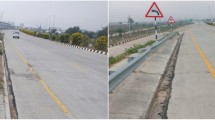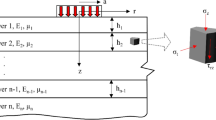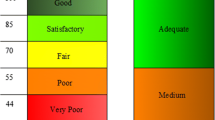Abstract
A computationally efficient surrogate model was developed based on artificial neural networks (ANN) to investigate the effect of the new generation of wide-base tires on pavement responses. Non-uniform tire contact stress measurements were obtained using a stress-in-motion instrument. The measured 3-D contact stresses were applied on two extreme 3-D flexible pavement finite element models representing low-volume (thin) and high-volume (thick) roads. Eleven critical pavement responses were modeled at two different material properties input levels—detailed and simplified—depending on data availability. The results rendered by the ANN surrogate models were highly accurate with average prediction error less than 5 % and R-square values higher than 0.95. In addition, two sensitivity analyses were performed to investigate the variables effect on pavement responses. It was found that the type of tire (wide-base vs. dual tire assembly) is more influential than the inflation pressure on pavement responses. However, the tire inflation pressure seemed to have a significant effect on near-surface responses. The developed models were incorporated into a tool to assist designers and engineers in investigating the effect of the pavement responses of wide-base versus dual tire assembly under typical loading conditions and pavement structures.











Similar content being viewed by others
References
Zaghloul S, White T (1993) Use of a three-dimensional, dynamic finite element program for analysis of flexible pavement. Transportation Research Record: Journal of the Transportation Research Board, No. 1388. Transportation Research Board of the National Academies, Washington, DC, pp 60–69
Saad B, Mitri H, Poorooshasb H (2005) Three-dimensional dynamic analysis of flexible conventional pavement foundation. J Transp Eng 131(6):460–469
Al-Qadi IL, Wang H, Yoo PJ, Dessouky SH (2008) Dynamic analysis and in situ validation of perpetual pavement response to vehicular loading. Transportation Research Record: Journal of the Transportation Research Board, No. 2087. Transportation Research Board of the National Academies, Washington, DC, 2008, pp 29–39
Yoo PJ, Al-Qadi IL (2008) Truth and myth of fatigue cracking potential in hot-mix asphalt: numerical analysis and validation. J Assoc Asph Paving Technol 77:549–590
Elseifi MA, Al-Qadi IL, Yoo PJ (2006) Viscoelastic modeling and field validation of flexible pavements. J Eng Mech 132(2):172–178
Hernandez JA, Gamez AM, Al-Qadi IL, De Beer M (2014) Analytical approach for predicting three-dimensional tire-pavement contact load. Transp Res Rec J Transp Res Board 2456:75–84
Gungor E, Hernandez JA, Gamez AM, Al-Qadi IL (2015) Quantitative assessment of the effect of wide-base tires on pavement response using finite element analysis. Transp Res Rec J Transp Res Board 2590:37–43
Wang H, Al-Qadi IL, Portas S, Coni M (2013) Three-dimensional finite element modeling of instrumented airport runway pavement responses. Transportation Research Record: Journal of the Transportation Research Board, No. 2367. Transportation Research Board of the National Academies, Washington, DC, pp 76–83
Wang H, Al-Qadi IL (2011) Impact quantification of wide-base tire loading on secondary road flexible pavements. ASCE J Transp Eng 137(9):630–639
Hernandez JA, Gamez AM, Al-Qadi IL (2015) Effect of wide-base tires on nationwide flexible pavement systems—numerical modeling. Compnedium of papers, 96th Annual Meeting, Transportation Research Board of National Academies, (16-4295), Washington D.C.
Wang H, Al-Qadi IL (2009) Combined effect of moving wheel loading and three-dimensional contact stresses on perpetual pavement responses. Transp Res Rec J Transp Res Board 2095:53–61
Al-Qadi IL, Wang H (2009) Full-depth pavement responses under various tire configurations: accelerated pavement testing and finite element modeling. J Assoc Asph Paving Technol 78:645–680
Karlaftis MG, Vlahogianni EI (2011) Statistical methods versus neural networks in transportation research: differences, similarities and some insights. Transp Res Part C 19:387–399
Vlahogianni EI, Karlaftis MG (2013) Testing and comparing neural network and statistical approaches for predicting transportation time series. Transp Res Rec J Transp Res Board 1367:9–22
Ceylan H, Bayrak MB, Gopalakrishnan K (2014) Neural networks applications in pavement engineering: a recent survey. Int J Pavement Res Technol 7(6):434–444
Saltan M, Uz VE, Aktas B (2013) Artificial neural networks-based backcalculation of the structural properties of a typical flexible pavement. Neural Comput Appl 23(6):1703–1710
Tabatabaee N, Ziyadi M, Shafahi Y (2013) Two-stage support vector classifier and recurrent neural network predictor for pavement performance modeling. J Infrastruct Syst 19(3):266–274
Tarawneh B, Nazzal MD (2014) Optimization of resilient modulus prediction from FWD results using artificial neural network. Period Polytech 58(2):143–154
Terzi S, Saltan M, Kucuksille EU, Karasahin M (2013) Backcalculation of pavement layer thickness using data mining. Neural Comput Appl 23:1369–1379. doi:10.1007/s00521-012-1083-2
NCHRP (2004) Guide for mechanistic-empirical design of new and rehabilitated pavement structures, NCHRP 1-37A final report. http://onlinepubs.trb.org/onlinepubs/archive/mepdg/guide.htm. Accessed 30 Sept 2015
Ceylan H, Gopalakrishnan K (2011) Computationally efficient surrogate response models for mechanistic-empirical pavement analysis and design. Struct Infrastruct Eng 7(4):297–304
Ceylan H, Gopalakrishnan K, Guclu A (2007) Advanced approaches to characterizing nonlinear pavement system responses. Transportation Research Record, No. 2005, pp 86–94
Michelin Americas Truck Tires. http://www.michelintruck.com/reference-materials/manuals-bulletins-and-warranties/load-and-inflation-tables/#/. Accessed 26 Apr 2016
Hernandez JA, Al-Qadi IL (2015) Hyperelastic modeling of wide-base tire and prediction of its contact stresses. J Eng Mech (ASCE), 04015084. doi:10.1061/(ASCE)EM.1943-7889.0001007
Hernandez JA, Al-Qadi IL (2015) Tire-pavement interaction modeling: hyperelastic tire and elastic pavement. Road Mater Pavement Des. doi:10.1080/14680629.2016.1206485
U.S. Federal Highway Administration (FHWA) Long-Term Pavement Performance (LTPP) standard release 26.0. https://www.fhwa.dot.gov/publications/focus/12jan/12jan07.cfm. Accessed 5 Apr 2015
Gopalakrishnan K (2010) Effect of training algorithms on neural networks aided pavement diagnosis. Int J Eng Sci Technol 2(2):83–92
Moghaddam FR, Afandizadeh SH, Ziyadi M (2011) Prediction of accident severity using artificial neural networks. Int J Civil Eng 9(1):41–49
Hamby DM (1995) A comparison of sensitivity analysis techniques. Health Phys 68(2):195–204
MATLAB and Statistics Toolbox Release (2015) The MathWorks, Inc., Natick
American Association of State highway and Transportation Officials (ASSHTO), AASHTOWare Pavement ME Design User Manual (2013). AASHTO, Washington, DC
Acknowledgments
The financial support provided by the Federal Highway Administration (FHWA) is greatly appreciated. This paper discusses some results from an ongoing pooled fund study, DTFH61-11-C-00025: The Impact of Wide-Base Tires on Pavement—A National Study. The project is being conducted in cooperation with the Illinois Center for Transportation, the U.S. Department of Transportation, Federal Highway Administration, Rubber Manufacturers Association, and the following state departments of transportation: Illinois, Minnesota, Montana, New York, Ohio, Oklahoma, Texas, and Virginia. The authors would also like to acknowledge the assistance of Jaime Hernandez and Angeli Gamez. This project is managed by Eric Weaver, who has been instrumental in providing directions and input. The contents of this paper reflect the view of the authors, who are responsible for the facts and the accuracy of the data presented herein. The contents do not necessarily reflect the official views or policies of the Illinois Center for Transportation, the Federal Highway Administration, or the participating partners. This paper does not constitute a standard, specification, or regulation.
Author information
Authors and Affiliations
Corresponding author
Rights and permissions
About this article
Cite this article
Ziyadi, M., Al-Qadi, I.L. Efficient surrogate method for predicting pavement response to various tire configurations. Neural Comput & Applic 28, 1355–1367 (2017). https://doi.org/10.1007/s00521-016-2442-1
Received:
Accepted:
Published:
Issue Date:
DOI: https://doi.org/10.1007/s00521-016-2442-1




